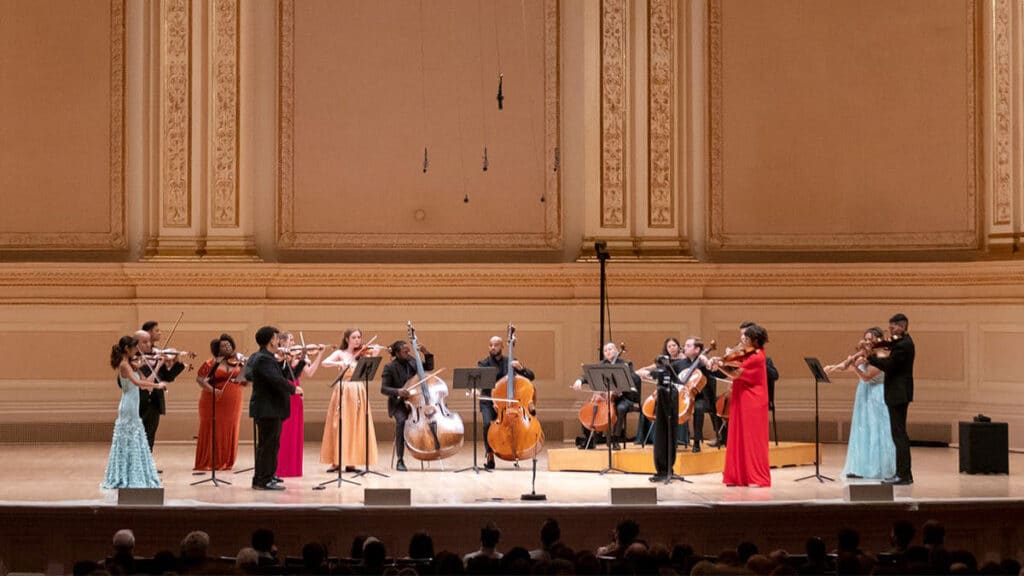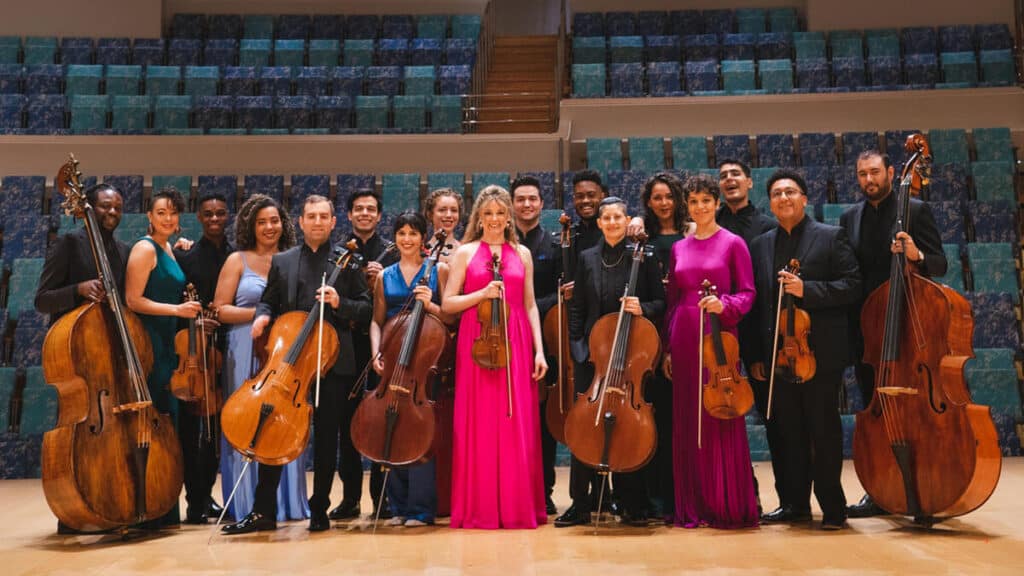
Sphinx Virtuosi is a chamber orchestra made up of the best students of The Sphinx Organization, a Detroit, Michigan social justice group that transforms lives through the power of diversity in the arts. These American cultural ambassadors showcase Black and Latin performers and composers of classical music and new music.
Sphinx Virtuosi in New York City
Sphinx Virtuosi plays an annual concert in October at Carnegie Hall, a major supporter of orchestras around the world. In the West African tradition of “Sankofa,” Sphinx Virtuosi looks back at our roots, so we can create the best possible future ~ together.
Sphinx Virtuosi “American Form/s,” 2024
Sphinx Virtuosi “American Form/s,” is a chamber concert of Black and Latin artists exploring American musical forms by playing Black and Latin composers from Carreño, to Joplin, to new music; on the Stern Auditorium / Perelman Stage at Carnegie Hall in Midtown, Manhattan; on Wednesday, October 16, 2024, at 7pm. 🇺🇸 🇻🇪
THE PROGRAM
CARREÑO Tempo di Marcia from Serenade for Strings
Teresa Carreño (1853-1917) was a New York Venezuelan, child-prodigy pianist, composer, singer, and conductor. She performed for Abraham Lincoln at the White House when she was just ten years old. That was during the American Civil War (1861-1865). Once that ended, America had a flowering of African Diasporic culture in gospel, ragtime, and blues, that came to define who we are as Americans today. Freedom grew fields of flowers. This is a famous piece of music. The United States Marine Band recorded it in 2021.
JOPLIN Overture from “Treemonisha” (arr. Jannina Norpoth; NY Premiere, co-commissioned by Carnegie Hall)
Scott Joplin, the “King of Ragtime” and composer of the “Maple Leaf Rag,” brought ragtime out of bars and put it on concert stages. This work is a bridge between serious opera and popular traditions. That’s very American. We take European art, stand it on its head, and make something even more interesting. This long forgotten opera was resurrected to great acclaim on Broadway in 1975. Jazz has since become accepted as the American opera, but this was the first African American opera to gain wide recognition. It’s a big deal. Joplin was posthumously awarded the Pulitzer Prize for music in 1976 for “Treemonisha.” @janninan
DERRICK SKYE “American Mirror,” Part One (arr. for string orchestra; NY Premiere, co-commissioned by Carnegie Hall).
You can hear many voices of the American experience in this beautiful composition. There is the European classical tradition, Scots-Irish jigs, and even the sound of the Orient which came to the Americas through Mother Afrika. The title suggests seeing yourself in the American experience, but also awareness of the parallel universes where Americans who are not of the European Diaspora live. Skye is based in Los Angeles. @iderrickskye
CURTIS STEWART “Drill” (NY Premiere, co-commissioned by Carnegie Hall)
Stewart is a multiple Grammy nominee on faculty at Juilliard, who also composes for the American Composers Orchestra. @curtis.stewart_violin
CURTIS STEWART “Double Down,” Invention #1 for Two Violins
LEVI TAYLOR “Daydreaming” (A Fantasy on Scott Joplin)
Taylor is a Kennedy Center Artist and multiple Emmy-nominated composer, based in Los Angeles. @levitaylormusic
When you dig into it, Sphinx Virtuosi is a great reservoir of incredible talent. All of this is important because most Americans are only recently beginning to realize how African and Latin we are. African culture is definitive of American culture. If it was magically taken away, we wouldn’t recognize our country, and probably wouldn’t recognize ourselves. Two-thirds of the United States was once New Spain and then Mexico, so we absorbed a lot of Latin culture as well.
Sphinx Virtuosi “Generations” 2023
Sphinx Virtuosi “Generations” showcases the beautiful diversity of Black and Latin classical music across the generations at Carnegie Hall.
The Black and Latin star musicians of Sphinx Virtuosi play chamber music by Black and Latin composers including Blache, Casarrubios, Foley, Villa-Lobos, and Perkinson, with songs by cellist and singer Abel Selaocoe; in the Stern Auditorium / Perelman Stage at Carnegie Hall in Midtown, Manhattan; on Friday, October 20, 2023 at 7pm. From $28. 🇺🇸 🇧🇷 🇿🇦 🇪🇸
The program is:
- QUENTON BLACHE Habari Gani (NY Premiere)
- ANDREA CASARRUBIOS Herencia (NY Premiere)
- PERKINSON Allegro vivace from Sinfonietta No. 2, “Generations”
- VILLA-LOBOS Aria (Cantilena) from Bachianas brasileiras No. 5
- XAVIER FOLEY Concertante for Two Double Basses and String Orchestra, “Galaxy” (NY Premiere, co-commissioned by Carnegie Hall)
- ABEL SELAOCOE “Qhawe”
- ABEL SELAOCOE “Lerato”
- ABEL SELAOCOE “Ka Bohaleng”
Quenton Xavier Blache is an African American cellist and composer from the University of Southern California (USC) Thornton School of Music. He is a Sphinx Virtuosi alumnus. quentonxavierblache.com | @qblache 🇺🇸
Andrea Casarrubios is a Spanish-born cellist and composer who plays the world’s great concert halls. andreacasarrubios.com | @andrea_casarrubios 🇪🇸
Coleridge-Taylor Perkinson (1932-2004) was an African American composer of jazz, pop, and classical music for dance, film and television. He had the blues in his soul. He was music director for Jerome Robbins’ American Theater Lab and Alvin Ailey American Dance Theater, and founded the Symphony of the New World. The show’s title comes from the Perkinson piece in the concert. He is now the old generation, but Perkinson himself looked to prior generations for his inspiration. 🇺🇸
Heitor Villa-Lobos (1887-1959) is the most famous Latin American classical music composer. He used Brazilian folk traditions and the sound of the Amazon jungle for inspiration. “Bachianas brasileiras” is one of his most famous works. It offers Brazilian themes in the style of J.S. Bach. Perfect because to be Latin is to be a child of both Old and New Worlds. 🇧🇷
Xavier Foley from Marietta, Georgia, is an African American double bassist. He is a 2014 Sphinx Competition winner who is touring the world with his “Galaxy Concertante.” xavierfoley.com | @xavierfoleybass 🇺🇸
Abel Selaocoe is a South African cellist who plays everything from classical music to hip-hop. He is a founder of Chesaba, an African music trio. abelselaocoe.com | @abelselaocoe 🇿🇦
Sphinx Virtuosi
The Sphinx Organization turns beginning students into seasoned classical music professionals, cultural entrepreneurs, and arts administrators. It’s important work because our world is more diverse than ever. The Sphinx Virtuosi are its best students. They perform on the world’s greatest stages including Carnegie Hall and The Kennedy Center. They record for Deutsche Grammophon, one of the world-famous classical music record labels.
The Sphinx is African. The riddle of the Sphinx is that cleverness defeats violence. It’s a metaphor for how love conquers hate, and something America needs now.
Classical music is often inspired by folk traditions. Black and Latin kids bring their own cultural frameworks to the classical music canon. The distribution of genius is equal among all races, places, and across time. When we diminish segments of our society, we are all diminished. The Sphinx Organization looks for genius, right here at home, perhaps in places you wouldn’t expect, and that elevates us all.
Albums
“Songs for Our Times” (2023) features the Sphinx Virtuosi with Australian violin soloist Amaryn Olmeda, and Cuban American cellist Tommy Mesa, on Deutsche Grammophon. sphinxmusic.org 🇺🇸 🇦🇺 🇨🇺
Social Media
X @SphinxOrg
Facebook @sphinxorganization
Instagram @sphinxorg
Tickets and Information

